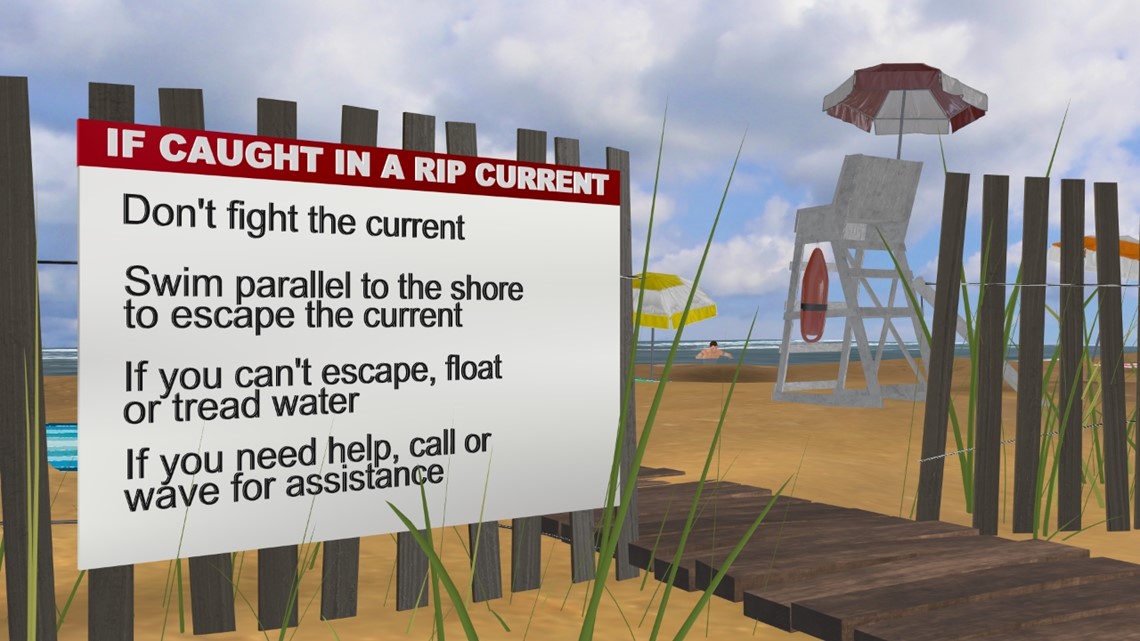OAK ISLAND, N.C. — Hurricane Idalia was a historic storm, causing storm surge of 10-plus feet in Florida's Big Bend Wednesday, blasting the town of Perry with strong sustained winds and heavy rain.
Idalia left a path of damage throughout northern Florida, Georgia, South Carolina and North Carolina. The storm's impacts included confirmed tornadoes, like the one that flipped a car in South Carolina.
Now Idalia will push east and dance out in the Atlantic over the next several days, but that doesn't mean we're totally in the clear.
Idalia will leave behind one major threat that will impact beach trips over Labor Day weekend in the Carolinas.
Idalia's last threat: rip currents
The shoreline of the Carolinas is a rough sea Thursday as Idalia is exiting east into the Atlantic. As it moves away from the Carolinas, the weather will improve for the holiday weekend but the threat for rip currents remains high.
The National Weather Service in Newport-Morehead City, North Carolina says that a high risk for rip currents means:
"Life-threatening rip currents are likely. The surf zone is dangerous for all levels of swimmers. Stay out of the water," they wrote. "Remember to heed the advice of the local beach patrol and flag warning systems."
A moderate rip current risk extends through the rest of the weekend.
"Life-threatening rip currents are possible. Always swim near a lifeguard and remember to heed the advice of the local beach patrol and flag warning systems," the weather service advised.
Rip currents can form on any day. A sunny day with waves only a foot or two can still have dangerous rip currents. Combined with an active tropical storm like Idalia offshore, and the threat can increase.
The where, what, why and how:
Where rip currents occur: They are most typically near breaks in a sandbar, as well as near jetties and piers. Rip currents can still be found at any beach that has breaking waves.
What is a rip current?
A rip current is a channelized current (like a treadmill) of water that flows away from shore. This usually extends beyond where the waves break. When caught in one, swimmers are quickly pulled away from the shore before some may even realize the danger. Rip currents have claimed the lives of even the strongest swimmers. Rip currents can carry someone on average one or two feet per second. The strongest rip current can move as fast as 8 feet per second, which is faster than an Olympic swimmer.
RAISE YOUR WEATHER IQ: Understanding rip currents
What to do when caught in a rip current


If you find yourself caught in a rip current:
- Don't fight the current
- Swim parallel to the shore to escape the current
- If you can't escape, float or tread water
- If you need help, call or wave for assistance
How rip currents form
A tropical storm or hurricane in the ocean lifts the water level beneath the center of the storm. This effect is what causes the storm surge when storms make landfall. The strong winds cause enhanced waves and a tumultuous sea. Even at great distances from a storm, waves breaking along the coast can produce deadly rip currents.
Rip currents form when waves push water upslope and onto the beach, like so many things in nature, an equilibrium or balance needs to be made. To achieve this balance, excess water building near the shoreline (or in the surf zone) will find a path to exit back out to sea. This forms a rip current.
The best conditions for rip currents to form:
- Wave direction perpendicular to the shore
- Larger wave heights
- Longer wave periods
- Low tide (Most common within a few hours of low tide but they can form any time of day).
RELATED: Yes, you can spot a rip current
How to spot a rip current
Rip currents are best seen from an aerial or elevated view but most of the time that is not possible.
Watch the water for several minutes looking for:
- A narrow gap of darker water
- Difference in water color
- A line of foam or seaweed moving out to sea
- A channel of choppy, whitewater moving away from the beach. This is likely called a 'flash rip'
Some Local Rip Current Facts
- Rip currents claim an average of eight deaths per year. 179 drownings have been recorded since 2000 for North Carolina and South Carolina. This is more than any other weather fatality reported.


- Of these 179 fatalities, 85% were male. This means males are five times more likely to drown from rip currents in the Carolinas.
- Most fatalities are from those who do not live in the coastal Carolinas. Instead, 81% of deaths are residents from inland communities.
- Over half (51%) of the deaths were vacationing from out of state.
- Most common age ranges: 41 to 50 years old for males and 31 to 40 years old for females.
- North Carolina has double the rip current fatalities as South Carolina.
Contact Chris Mulcahy at cmulcahy@wcnc.com and follow him on Facebook, X, Instagram and TikTok.
WCNC Charlotte’s Weather IQ YouTube channel gives detailed explainers from the WCNC Charlotte meteorologists to help you learn and understand weather, climate and science. Watch previous stories where you can raise your Weather IQ in the YouTube playlist below and subscribe to get updated when new videos are uploaded.

